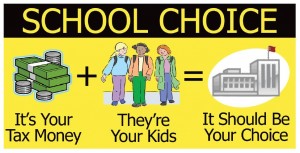AFFORDABLE
School choice lets parents use their own money to direct their own children’s education. It also encourage the direction of private money to support low-income and disabled children. This year, the Senate passed a budget with over $8 billion in local, state and federal funding for traditional public school districts. Bonds and other monies add another $2 billion to that. The maximum revenue impact of the tax credits and deductions in H.4894 is set at $37 million, or less than half of one percent of the public schools’ budget. More importantly, these types of program are proven to actually save money, since the size of the scholarships and deductions are so much less than per-pupil spending in the traditional public schools. Lost in the talking points against H.4894 is the fact that most state spending for K-12 education is not “tied” to the child, so traditional public schools still collect most of the money even after a child transfers out of the school.
ACCOUNTABLE
Schools answer to parents and students when families are free to make choices among them. As a state, we’ve come to confuse indicators with accountability. Too many parents receive complicated school report cards from the state but are unable to act on the information because they can not select a different school for their child. Even the terms of these so-called “accountability” tools for public schools have been muddled. Now failing schools are not called “F” but “At-Risk.” Parents who enroll their children at nonpublic schools can, at any time, transfer them out. Critics of school choice have also confused accreditation -something that many public schools receive from the state as a mater of course- with quality instruction and student achievement. School choice is the ultimate in accountability because answer directly and immediately to the parents who children are enroll at them.
ALL READY WORKING IN OTHER STATES
Eight years ago, reasonable people could disagree about what might happen if South Carolina passed School Choice legislation along the lines of House Bill 4894. Today, that is not the case. Real world experience trumps speculation and hearsay. Today there are active school choice programs in two-‐dozen states. We know from the actual experience of states that have enacted the programs most similar to H.4894 that school choice is affordable, accountable, and already working. We know these programs are widely popular with parents; that they reduce long-‐standing gaps in access to educational options; and that they spur innovation and competition among all types of schools, public and private. We know that school choice does not siphon money from traditional public schools, so there is no so-‐called “trade off” for this myriad of benefits



comments